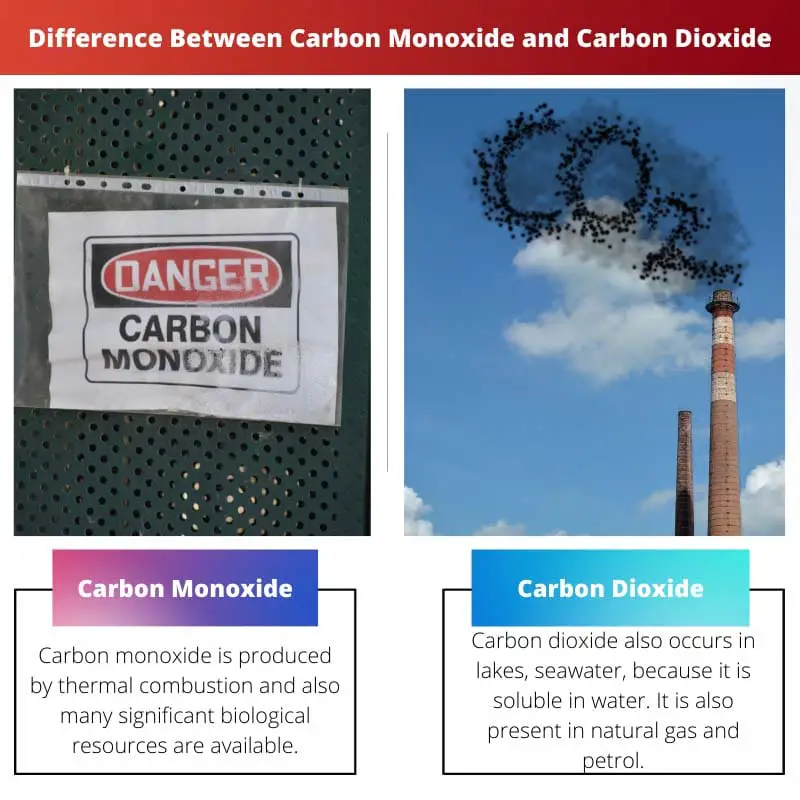Carbon monoxide and carbon dioxide are two different forms of air. Both of them are different from each other.
They have different properties and characteristics. Depending on the number of oxygen, they get differentiated into monoxide and dioxide.
Key Takeaways
- Carbon monoxide is a toxic, odorless gas produced by incomplete combustion, while carbon dioxide is a non-toxic byproduct of respiration and combustion.
- Carbon monoxide can be lethal when inhaled in high concentrations, whereas carbon dioxide threatens the environment through its greenhouse effect.
- Carbon monoxide detectors are necessary for home safety, while carbon dioxide levels are monitored for climate change and air quality concerns.
Carbon Monoxide vs Carbon Dioxide
Carbon monoxide is a toxic gas that does not occur normally, is colorless and odorless, and consists of a single carbon atom and a single oxygen atom. Carbon dioxide is a gas that occurs naturally in the atmosphere, consisting of a single carbon atom and two oxygen atoms. It is acidic and colorless.

Carbon monoxide is a fatal toxic gas that is not a naturally occurring gas. CO is the molecular formula of carbon monoxide.
Carbon monoxide is a colorless and odorless gas. Compared to the density of air, the density of carbon monoxide is slightly lower and flammable.
The combination of a single carbon atom and a single oxygen atom is called carbon monoxide. It comes under the oxocarbon family.
The coordination complex between carbon and oxygen atom is called carbonyl.
Comparison Table Between Carbon Monoxide and Carbon Dioxide
Carbon dioxide is a gas that naturally occurs in the atmosphere. Carbon dioxide is nothing but the combination of a single carbon atom and a double oxygen atom.
The bond between a carbon atom and an oxygen atom in carbon dioxide is called a covalent bond. Carbon dioxide is a trace gas that is acidic and colorless.
The current rate of carbon dioxide in the atmosphere is 412 rpm. Carbon dioxide is released from volcanoes, geysers, carbonate rocks, and plants.
Comparison Table
| Parameters of comparison | Carbon Monoxide | Carbon Dioxide |
|---|---|---|
| Molecular mass | The molecular mass of carbon monoxide is 28.01 g/mol | The molecular mass of carbon dioxide is 44 g/mol |
| Molecular Formula | The molecular formula for carbon monoxide is CO | The molecular formula for carbon dioxide is CO2 |
| Characteristics | Carbon monoxide is a flammable gas | Carbon dioxide is a non-flammable gas |
| Molar mass | The molar mass of carbon monoxide is 28.010 g/mol | The molar mass of carbon dioxide is 44.009 g/mol |
| Solubility in water | The solubility in water for carbon monoxide is 27.6 mg/L | The solubility in water for carbon dioxide is 1.45 g/L |
What is Carbon Monoxide?
Carbon monoxide is produced by thermal combustion, and many significant biological resources are available. It is a vital source or major ingredient in drugs and fragrances.
In industries, carbon monoxide is the key element for production. The production of carbon monoxide includes many organisms and human beings.
Carbon monoxide also plays a big part in climate change. The emission of carbon monoxide affects the atmosphere severely.
Carbon monoxide has a vital in biological factor. A low concentration of carbon monoxide will act as a neurotransmitter, whereas a high concentration of carbon monoxide acts as a toxic inhibitor.
When carbon monoxide reacts with cyanide, it becomes isoelectric. Carbonous oxide, Kohlenoxyd, and carboneum oxgenisatum are other names for carbon monoxide.
It is also called water gas, illuminating gas, and fuel gas.
Carbon monoxide poisoning is a type of breathing breaking. Since it affects your central nervous system, it causes headaches, chest pain, and vomiting.
The molar mass of carbon monoxide is 28.010 g/mol.
The melting point of carbon monoxide is −205.02 °C, and the boiling point of carbon monoxide is −191.5 °C. At 609 °C, the carbon monoxide will get auto-ignited.

What is Carbon Dioxide?
Carbon dioxide also occurs in lakes and seawater because it is soluble in water. It is also present in natural gas and petrol.
It is an odorless gas and generates a soda taste. The primary source of life on Earth is carbon dioxide. Human beings themselves exhale carbon dioxide.
Photosynthetic organisms regulate the balance of carbon dioxide. Plants inhale carbon dioxide and exhale oxygen, which balances the carbon cycle.
During the process called decay, carbon dioxide is released. Aerobic animals inhale oxygen and exhale carbon dioxide.
During the combustion of wood, carbon dioxide is released. All this gas released from various sources is balanced by planting more plants.
Carbon dioxide is used as an inert gas in welding and other industrial processes. It acts as a pressurizing gas in industries.
Carbon dioxide is an ingredient added to drinking water and beverages.
Frozen carbon dioxide is used as a refrigerant or dry ice blasting. In the earth’s atmosphere, carbon dioxide is a long-lived greenhouse gas.
Deforestation may increase carbon dioxide levels in the atmosphere and lead to global warming. When carbon dioxide dissolves in water, it produces carbonic acid, leading to ocean acidification.
The molar mass of carbon dioxide is 44.009 g·mol−1. Carbonic anhydride and Carbonic dioxide are some other names for carbon dioxide.

Main Differences Between Carbon Monoxide and Carbon Dioxide
- The bond length between carbon and oxygen atom in carbon monoxide is 112.8 pm, whereas, in carbon dioxide, it is 116.3 pm.
- The carbon and oxygen atom bond in carbon monoxide is a triple covalent bond or coordinate covalent bond, whereas, in carbon dioxide, it is a covalent bond.
- Carbon monoxide does not naturally occur in the atmosphere, whereas carbon dioxide naturally occurs in the atmosphere.
- Carbon monoxide affects your central nervous system, whereas carbon dioxide affects your respiratory system.
- The molecular mass of carbon monoxide is 28.01 g/mol, and the molecular mass of carbon dioxide is 44 g/mol.




